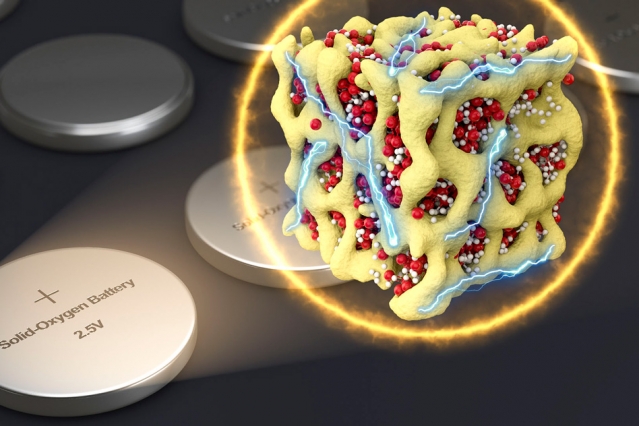
Image: MIT
New lithium-oxygen battery technology proposed by researchers from MIT, Argonne National Laboratory, and Peaking University, promises a scalable, cheap, and safe option in energy storage.
There is immense promise for lithium-oxygen batteries in such applications as electric cars and portable electronics. In fact, they are between five and 15 times more efficient than lithium-ion batteries in transportation applications due to their high energy output potential in proportion to their weight.
But there have been complications in developing and especially implementing these batteries in the marketplace. Primarily, they’ve been known to waste energy and degrade quickly.
But this new study, co-authored by ECS member and past IMLB chair Khalil Amine, states that the theoretical potential for lithium-oxygen batteries could be met while overcoming some of the biggest barriers prohibiting the technology.
Once of the primary focuses of the group was overcoming the mismatch in voltages that happens in charging and discharging the battery. Because the output voltage is more than 1.2 volts lower that that used to charge, there is typically a significant power loss.
“You waste 30 percent of the electrical energy as heat in charging,” says Ju Li, professor at MIT and co-author of the paper. “It can actually burn if you charge it too fast.”
This from MIT:
In the new variant, the same kind of electrochemical reactions take place between lithium and oxygen during charging and discharging, but they take place without ever letting the oxygen revert to a gaseous form. Instead, the oxygen stays inside the solid and transforms directly between its three redox states, while bound in the form of three different solid chemical compounds, Li2O, Li2O2, and LiO2, which are mixed together in the form of a glass. This reduces the voltage loss by a factor of five, from 1.2 volts to 0.24 volts, so only 8 percent of the electrical energy is turned to heat.
“This means faster charging for cars, as heat removal from the battery pack is less of a safety concern, as well as energy efficiency benefits,” Li says.
Another breakthrough with this battery is its inherent quality that protects it against overcharging. Unlike typical batteries of its kind that receive structural damage when overcharged, this technology’s reaction shift to a different form to prevent overcharging damage.
Through 120 charging-discharging cycles, the battery showed less than a 2 percent loss of capacity – thereby overcoming the lifespan hurdle.
All of this was made possible without adding any extra, expensive materials.

